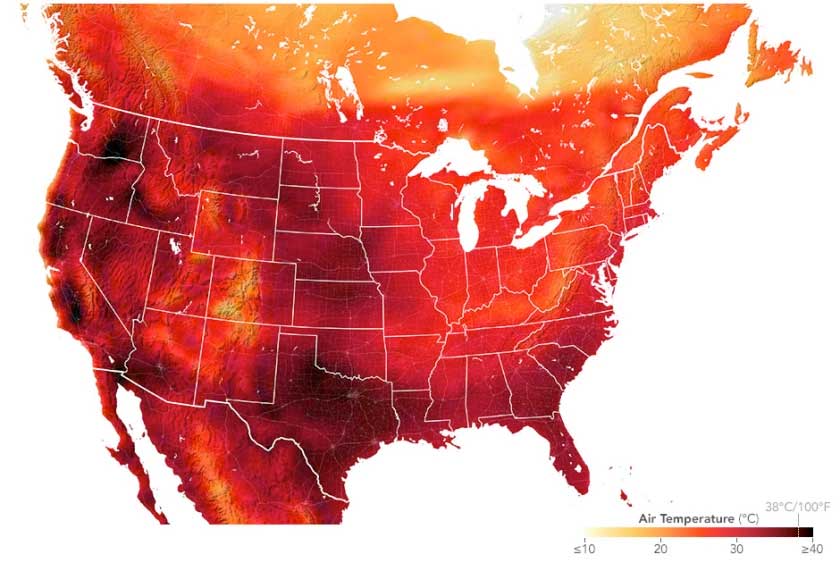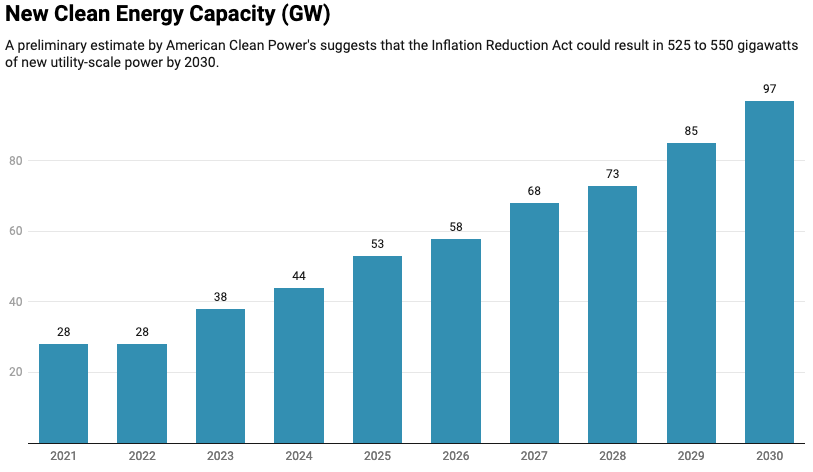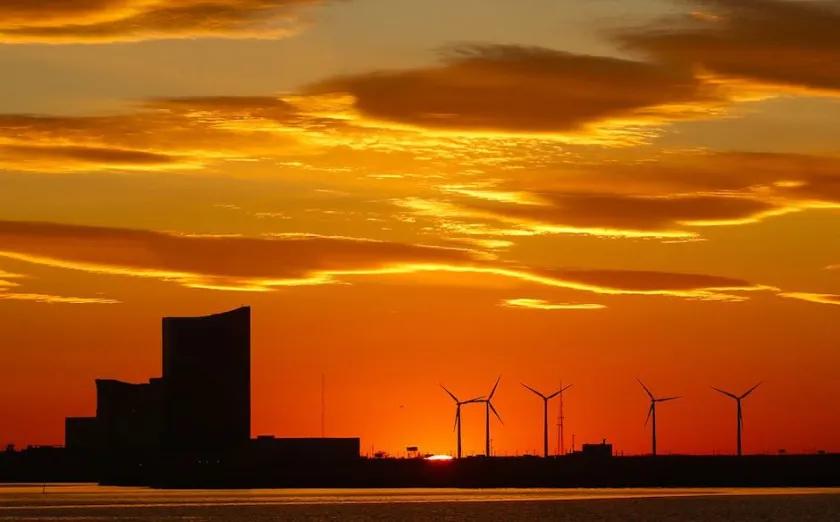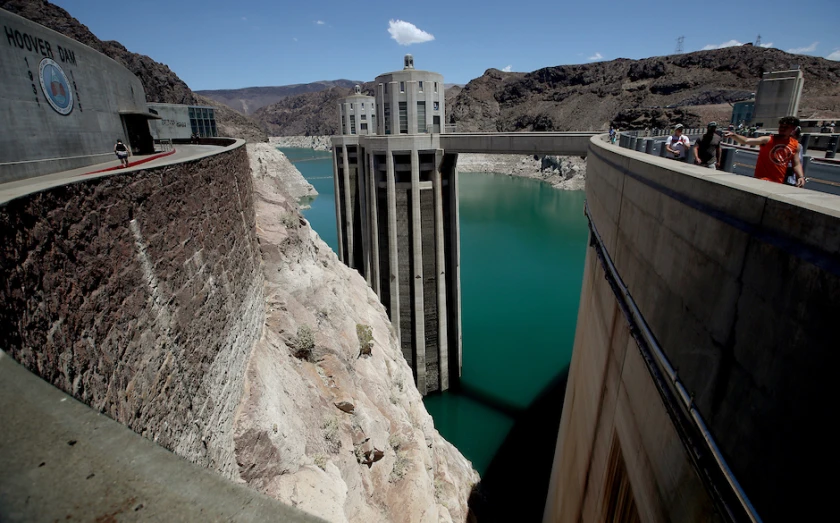At a White House ceremony on Tuesday, President Biden signed the Inflation Reduction Act (IRA) into law, fulfilling one of the key promises of his campaign by committing unprecedented federal resources to the fight against climate change.
Biden called it “one of the most significant laws in our history,” proof that America’s soul is vibrant and its future bright. “The bill I’m about to sign is not just about today,” he said. “It’s about tomorrow, it’s about delivering progress and prosperity to American families.” The passage of the bill demonstrates that democracy still works, said Biden, not only for the privileged but for all Americans.
The IRA allocates $369 billion over 10 years for energy security and climate relief, $64 billion for extending the Affordable Care Act and $4 billion to address the water crisis in the western states. It is the largest federal investment in climate action in the country’s history.
The bill aims to offset this spending through measures that include a 15 percent minimum tax on corporations with more than $1 billion in profits and prescription drug pricing reform. It hopes to reverse a dramatic decrease in audits of Americans with exceptionally high earnings by investing $80 billion in the IRS. The Senate has projected that these actions will raise $300 billion more than the IRA will spend.
The bill made it through both the Senate and the House without a single Republican vote, set in motion by a surprise deal between Sen. Joe Manchin and Senate Majority Leader Chuck Schumer. It ends a Congressional impasse on climate action that has frustrated scientists, public officials and activists for years.
“I am thrilled,” says Maryland Del. Lorig Charkoudian. “It has essentially been on the states to move climate policy forward, at times with zero support from the federal government, or the executive branch moving in the right direction but Congress unable to move.”
Mayors have been dealing with climate impacts far too long without federal support, says Houston Mayor Sylvester Turner, the chair of the bipartisan Climate Mayors network. He sees passage of the IRA as a step toward unified climate action. “Finally, cities will receive the aid they need to make real, equitable change for communities on the front lines of the climate crisis.”

In July, 150 million people were under heat warnings and advisories. A new report finds that by 2053, more than 100 million Americans in the center of the country could be living in an “extreme heat belt” with heat indexes above 125 degrees Fahrenheit. (NASA)
Is Inflation Really the Point?
Despite the bill’s name, the Penn Wharton Budget Model (PWBM) estimated that the impact of the IRA on inflation will be “not statistically different than zero.” The Congressional Budget Office (CBO) saw an equally small effect. (Though they didn’t offer numbers, a group of 126 economists wrote a letter to Senate leaders expressing the view that deficit reductions resulting from the IRA would create “downward pressure” on inflation.)
But controversy around the bill’s impact on inflation distracts from the fact that the IRA is benefit-heavy — PWBM also determined that its long-term benefits include higher wages, higher GDP and lower government debt.
The nonprofit Energy Innovation published an analysis of the impact of the IRA and concluded that the climate and energy funding in the IRA could create as many as 1.5 million jobs.
According to American Clean Power estimates, it will create over half a million new jobs in that sector alone, doubling the clean energy workforce, and catalyze $600 billion in private-sector investment in clean energy.
Energy Innovation expects the IRA to cut greenhouse gas emissions from 37 to 41 percent below 2005 levels by 2030, much closer to the Biden administration’s target of 50 percent than the 24 percent expected from existing state and local policies. States and the private sector will need to fill the gap, but the 50 percent target may now be in the realm of possibility.

Chart: Governing Source: ACP
The Central Role of Tax Credits
State and local efforts to move to zero-carbon energy will gain momentum from the IRA’s clean electricity tax incentives. These include tax credits for renewable energy production, investment in clean energy technology manufacturing, and grants and loans for energy transmission projects. Incentives are enhanced for wind and solar projects that bring clean power to low-income communities.
Despite a piecemeal system and fluctuation in values, tax credits have had more impact on advancing renewable energy in the U.S. than any other federal policy, says Daniel Esposito, senior policy analyst at Energy Innovation. “The Inflation Reduction Act brings these tax credits together in a long-term, cohesive policy that’s a lot more expansive, that includes basically any zero-emission power source.”
This is good news for developers, but it also means that clean energy will become cheaper than ever over the 10-year period when these credits are available under the IRA. States might want to consider updating their renewable portfolio standards, Esposito says. “If I’m a state that has a longer-term target, I would want to set a more ambitious target for 2030 — maybe this will be the end of it for tax credits after this policy.”
For regulators, the incentives could change the economics of building new natural gas plants to generate electricity. Credits are increased by 10 percent for projects in census tracts where coal mines have been closed or coal-fired generators retired, or those adjoining them. “These communities can thrive, with high-paying jobs, worker training programs and even new manufacturing facilities that produce the components that go into these projects,” says Esposito.
Support for building new transmission capacity could foster more cooperation and cost sharing between states to address regional bottlenecks in getting new projects online. It could also add pressure to resolving issues around delays in proposed projects seeking “interconnection” approvals, the right to connect the power they generate to the electricity grid. Lawrence Berkeley National Lab has estimated that at the end of 2021, projects representing 676 gigawatts (GW) of solar power, 247 GW of wind power and 427 GW of storage were in line for interconnection agreements.
“It’s a problem that’s going to need to be worked through independently of the IRA, but what the IRA can do is get more projects squeezed through than if we didn’t have this new federal money,” says Esposito.
Opportunities for States
There are numerous sources of funding in the IRA to support the climate plans and programs of state, local and tribal governments. Some examples:
A $27 billion Greenhouse Gas Reduction Fund will form the basis for the first national green bank, funds that can also be available to state or regional green banks. Sixty percent must go to disadvantaged communities, for uses such as community solar and promoting environmental justice.
Other grant programs offer billions to improve quality of life in these communities by establishing urban forests and parks, for community resilience and water supply projects in communities that lack reliable domestic water supplies.
Grants will be available to address air pollution, including $3 billion to support climate action plans for ports and the purchase of zero-emission technology and equipment for them. A billion-dollar clean heavy-duty vehicle program can help with the costs of zero-emission transit buses, garbage trucks and school buses, with a focus on vehicles serving nonattainment areas.
More than $4 billion is available to help states create rebate programs for homeowners who achieve demonstrated energy savings, including those in apartments and affordable housing. There is funding for states to give rebates of up to $14,000 to electrification projects in low- and moderate-income households or apartment buildings.
Billions more are allocated for tax credits and rebates to consumers for purchases including new and used clean vehicles, energy efficient appliances, and rooftop solar or heat pumps.

The sun sets behind the Jersey-Atlantic Wind Farm. IRA funding is expected to increase development from wind lease opportunities in the region in 2023. (Tim Hawk/TNS)
One State’s View of IRA’s Benefits
The IRA doesn’t relieve states from a responsibility to act, but it’s a “new ballgame” for them to be able to work in partnership with the federal government, says Maryland legislator Charkoudian.
In April, Maryland enacted a law that raised its greenhouse gas emission reduction target from 40 percent by 2030 to 60 percent by 2031, and set a 2045 deadline for zero emissions across the state’s economy. Support for the bill was strong enough for it to become law without a signature from Gov. Larry Hogan.
Charkoudian has begun to study the IRA provisions and already sees many ways it can accelerate progress toward her state’s goal. It will make it possible for more to come from wind lease opportunities off the Atlantic coast that will become available in 2023, including the availability of funding to improve transmission capacity. IRA provisions that support a domestic supply chain for renewable technology could add momentum to a redevelopment project that is transforming a former steel plant in Baltimore County into a logistics hub.
In the past year, Charkoudian passed a bill to create a grant program for microgrids in low-income communities that can serve as “resilience hubs” during extended power outages. The IRA creates the potential for federal funds to be added to the state’s allocation for the program. “I’m thinking about how much more quickly we’re going to be able to build those out, to add to the resilience of the community,” she says.
The state has made strides in increasing building efficiency, becoming a national model of progress in this regard. But improvements in low-income housing, where energy costs create the largest financial burden, have lagged far behind. Charkoudian sees a resource to speed this work and for other projects, such as the conversion of a former coal power plant to develop clean energy.
“Now it’s on the states to make sure we are setting up structures to maximize the flow of money into the state, maximize the benefits for our economies and for clean energy and maximize the justice framework for how the money gets spent,” Charkoudian says.

Children play baseball on a field overlooking the Port of Los Angeles. The IRA includes funding to address air pollution in disadvantaged communities, including support for zero-emission technology and equipment at ports. (Luis Sinco/TNS)
The Disadvantaged Community Question
Susan Asam, vice president of climate planning at the consulting firm ICF, which advises clients in state and federal government as well as the private sector on climate strategies, finds the funding for climate resilience in disadvantaged communities to be especially noteworthy.
“That’s a real need that is not being addressed and has not had any money obligated to it,” she says. “I still have a concern that getting money from the federal government to the communities that most need it is going to be hard — we’ve seen in the past that competitive grant programs can sometimes result in the rich getting richer.”
State and local clients have already let ICF know they are interested in exploring the use of greenhouse gas reduction funds to create green banks. Asam expects to see more of this, and a rapid phase of learning lessons regarding the best ways to set up these entities.
Opportunities can be lost if state and local governments don’t revisit their climate policies and take a hard look at how existing rules affect the investments they could capture from the IRA. “I hope that across the country we’ll see more assertive goals to really evolve our energy systems,” says Asam. “Consumers are going to get excited about what they can get out of this, and local governments can be part of the solution without having to concede to political opposition.”
The policy climate could also be a factor in bringing private investment that the IRA will catalyze to a state. “That’s going to launch a lot of jobs, hopefully even more than what is being modeled because of the third-party, fourth-party, fifth-party actors that I think are really going to start moving,” says Asam.

Visitors walk around the Hoover Dam. The white ring around the dam and adjacent Lake Mead shows how much the water has fallen due to overuse and climate change. (Luis Sinco/TNS)
Drought Relief
The IRA includes $4 billion for the Bureau of Reclamation (USBR) to use to address drought in the west, where the past two decades have been the driest in 1,200 years.
The allocation is “a ray of hope across a miserable landscape of pain,” says Felicia Marcus, a visiting Fellow at Stanford University’s Water in the West Program and past chair of the California State Water Resources Control Board. “It couldn’t be more timely.”
The Bureau of Reclamation has given the seven Colorado River Basin states an Aug. 15 deadline to cut their water use between 15-25 percent, or have restrictions imposed on them. This is necessary to prevent an even worse situation in coming years, says Marcus, but agriculture uses between 70 and 80 percent of the water delivered from the Colorado River. Cuts threaten both the livelihoods of farmers and food supply.
A plan submitted in July by upper basin states did not address cuts at the level requested, calling for the lower basin states of California, Arizona and Nevada to act first.
Purchasing water to offset cuts is an allowed use of the IRA funds, as are conservation efforts and ecosystem and habitat restoration. These can help ease the pain of farmers and also the communities that rely on farming.
This alone won’t fix problems in the Colorado Basin, says Marcus, but it’s a tool to do far more than would be possible without the bill.
Climate and Economy
In years past, it was common wisdom that climate action required sacrifice, says Esposito, but the economics have changed over the past 10 or 20 years.
“We can make huge emissions reductions while benefiting everybody in terms of affordable energy, better public health, better public safety, better jobs,” he says. “It’s a win, win, win, if we can manage to not get in our own way.”
ICF’s Asam sees an opening to move beyond partisan debate and embrace the full range of benefits from an energy transition, which include economic opportunity.
The IRA includes $9 billion to fund federal procurement of clean technologies made in the U.S., billions in tax credits to foster domestic production of wind turbines, solar panels and batteries and $2 billion in grants to refit existing auto manufacturing plants to produce clean vehicles. Projects that meet its requirements for domestic content receive extra tax credits.
These measures are intended to make up some of the ground the U.S. ceded to other countries by past inaction, and Asam expects some pushback from those who see this as a threat to their markets. The European Union has already protested that IRA requirements for domestic content and assembly of batteries for EV tax credits are incompatible with WTO rules.
This is just one example of many issues that will likely emerge as governments at all levels attempt to channel another enormous influx of funding, following COVID-19 relief and historic infrastructure investments that are still being unpacked. As much as she welcomes it, Del. Charkoudian doesn’t see long-awaited action by Congress as a climate “solution.”
“It gives us the tools,” she says. “The pieces are there and now state policy can build on these pieces.”
Republished with permission from Governing Magazine, by Carl Smith

Governing
Governing: The Future of States and Localities takes on the question of what state and local government looks like in a world of rapidly advancing technology. Governing is a resource for elected and appointed officials and other public leaders who are looking for smart insights and a forum to better understand and manage through this era of change.
